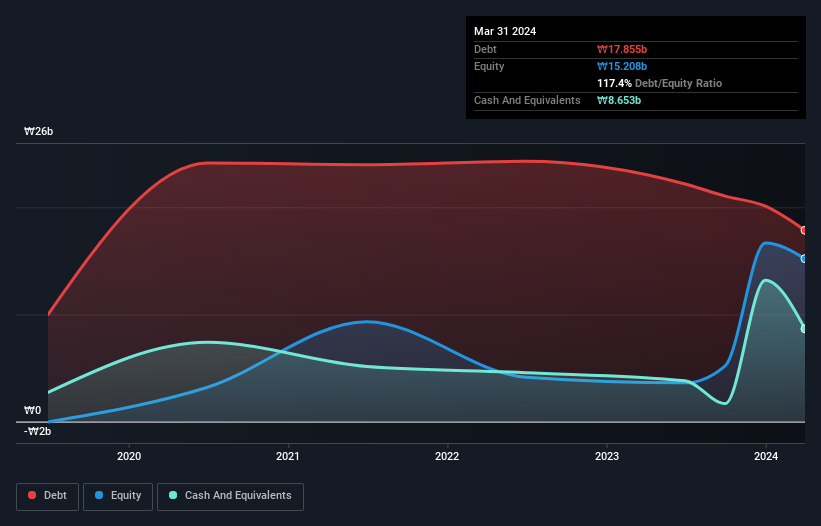
Some say volatility, rather than debt, is the best way to think about risk as an investor, but Warren Buffett famously said that 'Volatility is far from synonymous with risk.' So it seems the smart money knows that debt - which is usually involved in bankruptcies - is a very important factor, when you assess how risky a company is. As with many other companies Atum Co.,Ltd (KOSDAQ:355690) makes use of debt. But is this debt a concern to shareholders?
What Risk Does Debt Bring?
Debt assists a business until the business has trouble paying it off, either with new capital or with free cash flow. In the worst case scenario, a company can go bankrupt if it cannot pay its creditors. However, a more common (but still painful) scenario is that it has to raise new equity capital at a low price, thus permanently diluting shareholders. Having said that, the most common situation is where a company manages its debt reasonably well - and to its own advantage. The first thing to do when considering how much debt a business uses is to look at its cash and debt together.
Check out our latest analysis for AtumLtd
How Much Debt Does AtumLtd Carry?
You can click the graphic below for the historical numbers, but it shows that AtumLtd had ₩17.9b of debt in March 2024, down from ₩22.2b, one year before. However, it also had ₩8.65b in cash, and so its net debt is ₩9.20b.

A Look At AtumLtd's Liabilities
Zooming in on the latest balance sheet data, we can see that AtumLtd had liabilities of ₩19.4b due within 12 months and liabilities of ₩5.57b due beyond that. Offsetting this, it had ₩8.65b in cash and ₩7.33b in receivables that were due within 12 months. So its liabilities outweigh the sum of its cash and (near-term) receivables by ₩9.02b.
Given AtumLtd has a market capitalization of ₩68.4b, it's hard to believe these liabilities pose much threat. Having said that, it's clear that we should continue to monitor its balance sheet, lest it change for the worse. When analysing debt levels, the balance sheet is the obvious place to start. But it is AtumLtd's earnings that will influence how the balance sheet holds up in the future. So when considering debt, it's definitely worth looking at the earnings trend. Click here for an interactive snapshot.
Over 12 months, AtumLtd made a loss at the EBIT level, and saw its revenue drop to ₩43b, which is a fall of 12%. That's not what we would hope to see.
Caveat Emptor
While AtumLtd's falling revenue is about as heartwarming as a wet blanket, arguably its earnings before interest and tax (EBIT) loss is even less appealing. Indeed, it lost a very considerable ₩7.4b at the EBIT level. Considering that alongside the liabilities mentioned above does not give us much confidence that company should be using so much debt. So we think its balance sheet is a little strained, though not beyond repair. Another cause for caution is that is bled ₩5.0b in negative free cash flow over the last twelve months. So in short it's a really risky stock. When analysing debt levels, the balance sheet is the obvious place to start. But ultimately, every company can contain risks that exist outside of the balance sheet. Be aware that AtumLtd is showing 4 warning signs in our investment analysis , and 3 of those are potentially serious...
At the end of the day, it's often better to focus on companies that are free from net debt. You can access our special list of such companies (all with a track record of profit growth). It's free.
New: Manage All Your Stock Portfolios in One Place
We've created the ultimate portfolio companion for stock investors, and it's free.
• Connect an unlimited number of Portfolios and see your total in one currency
• Be alerted to new Warning Signs or Risks via email or mobile
• Track the Fair Value of your stocks
Have feedback on this article? Concerned about the content? Get in touch with us directly. Alternatively, email editorial-team (at) simplywallst.com.
This article by Simply Wall St is general in nature. We provide commentary based on historical data and analyst forecasts only using an unbiased methodology and our articles are not intended to be financial advice. It does not constitute a recommendation to buy or sell any stock, and does not take account of your objectives, or your financial situation. We aim to bring you long-term focused analysis driven by fundamental data. Note that our analysis may not factor in the latest price-sensitive company announcements or qualitative material. Simply Wall St has no position in any stocks mentioned.
About KOSDAQ:A355690
AtumLtd
Focuses on manufacturing and selling high-speed charger parts for smartphones.
Adequate balance sheet and slightly overvalued.
Market Insights
Community Narratives



